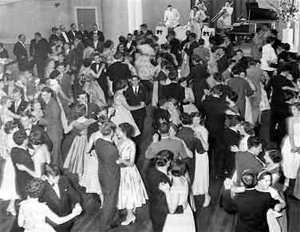Superconductivity: A Dance Analogy
J. Robert Schrieffer
Introduction by Charles Slichter: Let's now hear Bob Schrieffer explain how they put together lots of Cooper pairs to explain superconductivity, in terms of an analogy to many couples dancing on a crowded dance floor. In it he tries to give you a feel for why the assembly of Cooper pairs (or dancing couples), acting together, inhibit the scattering of electrons which ordinarily produce electrical resistance, and thus why a current can persist.
![]() Download complete audio file (4.30MB)
Download complete audio file (4.30MB)
 |
| J. Robert Schrieffer |
SCHRIEFFER: Suppose that you say that you have a large number of couples on a dance floor, and every male has an up spin and a female has a down spin, so they're up and down spin electrons. They're doing a frug, or whatever, where they never touch each other and are very far apart and dancing around this dance floor. Okay. They may be, say, a couple of hundred feet apart. But they always know exactly to whom they are mated, who's their partner, and yet there are roughly one million other pairs dancing in the area corresponding to the space in between those two areas — the cube root, or the two-thirds root of that — about 10,000 people.
Now, these dancing couples are essentially totally covering the dance floor. There is very little space not covered by people. So when they dance they have to do a highly intricate step of moving into a space that, at that instant, happens to be vacant. And this is enormously complicated choreography, so that one doesn't trip, if you like, or hit someone else. And the electrons can't hit each other, or at least they can't occupy the same space at the same time. Fine. So they're all dancing together. By dancing, if you like, they lower their energy or make themselves happier or whatever analogy you like to make.
Now, suppose that the dance floor is tipped. Or, another way of saying it, somebody starts pushing on one end of the dancing group and the dancing group starts to drift across the dance floor. Everybody still doing the same choreographed step, not in the rest frame, but in the moving frame.
 |
| Dancers in the Burnside Ballroom during the late 1950's; Courtesy: City of Burnside, www.burnside.sa.gov.au |
Suppose, however, that there happen to be some wood chips or nails or what have you sticking up from the floor — and these correspond to the impurities or defects in the superconductor, or lattice vibrations that are thermally excited — then, say, a given mate of a pair would tend to be tripped. But, unfortunately, there's no space for that mate to go into because it's occupied by another one. Or, if it does go into the wrong space where it shouldn't have gone, it gets out of synchronism, or dance pattern, choreography, with its mate and can no longer dance. Ergo, its energy goes up discontinuously.
The only way, to slow down the entire ensemble is not differentially, pair by pair by slowing down, because that increases the energy. The only way to slow it down and decrease the energy is for the entire dancing ensemble to slow down. And that's very unlikely if they're just random bumps around the floor.
So the choreographic notes, if you like, or that thing which is written down by the choreographer to tell everybody how to dance, or at least describe how they do dance — you know, it may be that God created all these people beautifully choreographed and all we did is figure out what the dance pattern is and we wrote it down. And instead of taking 200 volumes, it turns out to take two lines. And, if you get the right language it appears enormously simple. If you have the wrong language, you probably couldn't write it down — I'm sure you couldn't write it down in all the volumes in the entire world. If you write it down in coordinate space, there are 10²³ electrons. And to write down even 10²³ symbols would take more than all the paper in the universe. So you write it in a symbolic way which is enormously simple, allows you to calculate with it and make predictions without ever writing the thing down in its gory details.
The wave function is just... symbols which record the dance the electrons are making.
Now, we didn't invent the dance. Kammerlingh-Onnes discovered that the dance was going on and we were the choreographers that recorded what the dance was.
Still confused? Exit this exhibit to see other ways to explain the theory (from superconductors.org)
